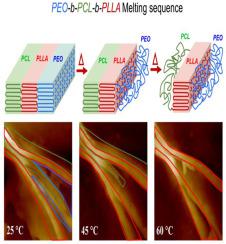Polymer ( IF 4.1 ) Pub Date : 2020-08-04 , DOI: 10.1016/j.polymer.2020.122863 Jordana K. Palacios , Heng Zhang , Bin Zhang , Nikos Hadjichristidis , Alejandro J. Müller

|
In this work, we provide a detailed description of the tri-lamellar nanoscale morphology of a triple crystalline PEO-b-PCL-b-PLLA triblock terpolymer obtained by Hot-Stage Atomic Force microscopy (AFM) imaging and Wide Angle X-ray scattering (WAXS) analysis for the first time. The precursor PCL-b-PLLA diblock copolymer has also been included in the study for comparison purposes. A two-step crystallization protocol has been applied to create a distinct lamellar morphology. Both WAXS and AFM revealed the double crystalline nature of the diblock copolymer. However, the identification of multiple crystalline phases in the triblock terpolymer by AFM and WAXS at room temperature is not straightforward. The advantages of hot-stage AFM allowed following the evolution of the lamellar morphology and the successive melting of the tricrystalline PEO-b-PCL-b-PLLA sample during heating. Taking into account the melting temperature of each crystalline block, the existing lamellar populations were clearly identified. At 45 °C, the thinnest lamellae disappeared, due to the melting of PEO crystals. The medium size lamellae disappeared at 60 °C when PCL crystals melt. At that temperature, the only remaining crystals are those of the PLLA block. AFM mechanical modulus images and the analysis of the cross-sectional heights provide further evidence of the lamellar self-assembly of the triblock terpolymer. It was found that two lamellar arrangements are possible at room temperature; either a perfect interdigitation where PCL and PEO lamellae are sandwhiched between PLLA lamellae (i.e., PLLA/PEO/PCL/PLLA), or only one PEO or PCL lamella in between two PLLA lamellar crystals distributed randomly (i.e., PLLA/PEO/PLLA or PLLA/PCL/PLLA). Hot-Stage AFM is a valuable technique to elucidate the complex morphological features of multi-crystalline systems.
中文翻译:

原位热阶段原子力显微镜直接鉴定PEO-b-PCL-b-PLLA三嵌段三元共聚物中的三个晶相
在这项工作中,我们提供了通过热原子力显微镜(AFM)成像和广角X射线散射获得的三晶PEO- b -PCL- b -PLLA三嵌段三元共聚物的三层纳米级形态的详细描述。(WAXS)分析。前体PCL- b-PLLA二嵌段共聚物也已包括在研究中以进行比较。两步结晶方案已应用于创建独特的层状形态。WAXS和AFM均显示了二嵌段共聚物的双晶性质。但是,在室温下通过AFM和WAXS鉴定三嵌段三元共聚物中的多个晶相并不容易。热阶段原子力显微镜的优点是随着层状形态的演变以及三晶PEO- b -PCL- b的连续熔化而得以实现-加热期间的PLLA样品。考虑到每个晶体块的熔化温度,可以清楚地识别出现有的层状种群。在45°C时,由于PEO晶体的熔化,最薄的薄片消失了。当PCL晶体融化时,中等尺寸的薄片在60°C时消失。在该温度下,仅剩余的晶体是PLLA块的晶体。AFM机械模量图像和横截面高度分析为三嵌段三元共聚物的层状自组装提供了进一步的证据。发现在室温下可能有两个层状排列。可以是在PLLA薄片(即PLLA / PEO / PCL / PLLA)之间打磨PCL和PEO薄片的理想交叉指,或者是在随机分布的两个PLLA薄片晶体之间只有一个PEO或PCL薄片(即,PLLA / PEO / PLLA或PLLA / PCL / PLLA)。高温原子力显微镜是阐明多晶系统复杂形态特征的一项有价值的技术。











































 京公网安备 11010802027423号
京公网安备 11010802027423号